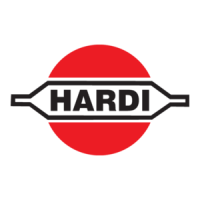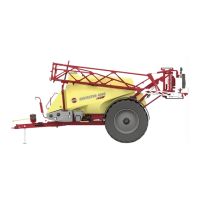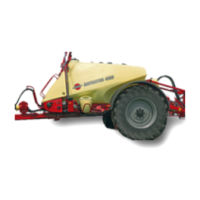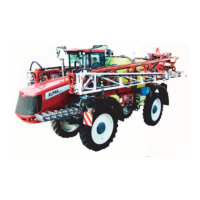22
HARDI NAVIGATOR
AGRICULTURAL CHEMICAL RESIDUES CAN DESTROY YOUR NEXT CROP!
CLEANING and DECONTAMINATION
as part of ongoing HARDI SPRAYER
MAINTENANCE AND SERVICE
In order to derive full benefit from the sprayer for many
years, the following maintenance program should be
followed.
To effectively maintain the sprayer you must:
1 Perform Cleaning of the entire sprayer after spraying
is completed. See Cleaning Procedure (next page).
Some chemicals also require stringent decontamina-
tion procedures to ensure any particles that may
have adhered to sprayer system surfaces are ren-
dered neutral before spraying a new crop or using
another chemical. See Decontamination (P 24).
Specific cleaning of filters also forms part of the
service and maintenance intervals - Refer to your
Maintenance and Service Manual .
2 Perform Lubrication according to the lubrication
interval reached - Refer to
Lubrication
(Maintenance
and Service Manual).
3 Perform Service and maintenance jobs according
to the service and maintenance interval reached -
Refer to schedules in the Maintenance and Service
Manual.
4 Perform Occasional maintenance jobs as needed
following inspections - Refer to
Occasional mainte-
nance
(Maintenance and Service Manual).
5 Immediately fit Replacement parts for parts that are
worn or broken - Refer to
Replacement Parts
(Main-
tenance and Service Manual).
IMPORTANT! Always read carefully through individual
paragraphs of procedures before starting the job.
If any portion remains unclear or requires facilities
which are not available, then for safety reasons
please leave the job to your HARDI dealer’s
workshop.
NOTE! For specific maintenance procedures for the
boom, please refer to your
Boom Operator’s
Manual
supplied with your sprayer documentation.
GENERAL CLEANING GUIDELINES
IMPORTANT! The entire fluid system, including
main tank, flush tank, chemical induction
system and all hoses, valves, spray lines and
nozzles, must undergo decontamination during
the cleaning procedure to ensure the sprayer is
free of chemical residue before storage or
using a different chemical.
Read the detergents and deactivating agents labels.
Read the whole chemical label. Take note of any par-
ticular instructions regarding recommended protective
clothing, deactivating agents, etc. If cleaning procedures
are given, follow them closely.
Be familiar with local legislation regarding disposal of
chemical washings, mandatory decontamination meth-
ods, etc. Contact the appropriate body, e.g. Department
of Agriculture or Environmental Protection Authority.
Chemical washings can usually be sprayed out on a
soakway. This is an area of ground that is not used for
cropping. Seepage or runoff of residue into streams,
water courses, ditches, wells, springs, etc., must be
avoided. Washings from the cleaning area must not
enter sewers.
NOTE! Well-calibrated sprayers ensure minimal
spray solution is left over after each spraying job.
It is good practice to clean the sprayer immediately after
use, thereby rendering the sprayer safe and ready for
the next chemical application. This also prolongs the life
of the components.
NOTE! It is sometimes necessary to have spray
liquid in the tank for short periods (eg. overnight) or
until the weather becomes suitable for spraying
again. Unauthorised persons and animals
must not have access to the sprayer under
these circumstances.
If the spray product used is corrosive, it is recom-
mended to coat all metal parts of the sprayer, before
and after use with a suitable rust inhibitor.
REMEMBER! Clean sprayers are safe sprayers.
Clean sprayers are ready for use and will not
be damaged by chemicals.
NOTE! If the sprayer is cleaned with a high
pressure cleaner (or fertiliser has been used),
lubrication of the entire sprayer is recommended -
including the boom. (Refer to
Lubrication
in your
Maintenance and Service Manual)
(Refer also to the boom Operator’s Manual sup-
plied with your sprayer documentation).

